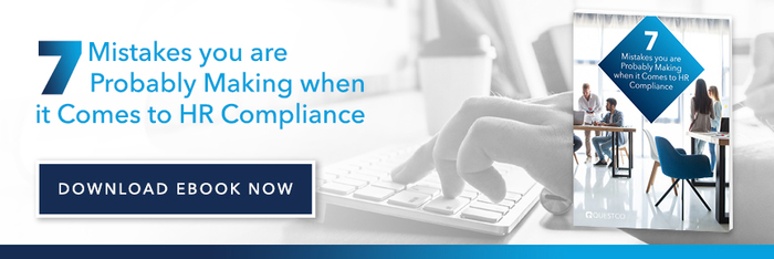Topic Risk Management
How to stay up to date with Regulatory Compliance Changes
.jpeg)
January 22, 2021 | By Christie Obrien
.jpeg)
Between federal agencies and commissions, thousands of new "rules" get issued each year, with a few hundred solid laws in the fold. For the average small business owner, navigating this treacherous regulatory landscape can be disheartening. In fact, studies suggest that many SMBs pay over $80,000 in fines during their first year of operations. Not only is compliance a financial burden from a fine and penalty perspective, but staying abreast of compliance changes and new regulatory guidelines saps resources and time.
Surprisingly, a plurality of small business owners aren't as concerned with the financial side of regulatory compliance as they are with the sheer complexity and ambiguity of many of the rules and laws. Forty-four percent of owners admit that the "difficulty of interpreting and understanding rules" and the "complexity of rules" are their biggest barrier to successful compliance.
Despite the incredible scale and openness of the internet, staying up-to-date on bureaucratic changes to the regulatory landscape is nearly impossible. There are simply too many flooding the gates, and unraveling a single rule change can send you deep into the trenches of subscript notes, appendixes, and alternative laws and rulings. A simple misunderstanding of a single rule or law can result in significant fines and reputational damage.
So, how should businesses approach this regulatory tornado? How can you find a way to stay informed on regulatory needs while simultaneously securing the right tools and resources to implement those changes across your business ecosystem?
The 4 Avenues for Approaching Regulatory Compliance
There's tangible value in both reducing the costs of adherence to regulatory needs as well as increasing your regulatory posture.
Here are the four primary ways businesses navigate the regulatory landscape.
1. Online Resources
Yes. You can try to go "solo" with regulatory compliance. You can browse massive lists that contain updates for regulatory changes, and there are plenty of blogs dedicated to compliance. However, it's important to understand the scale of regulations. There are +900 regulatory agencies issuing a whopping +200 regulatory updates every single day. There's a reason that compliance officers rank "continuing regulatory changes" as their biggest hurdle to compliance.
This isn’t to say that business-driven regulatory compliance can't be done. However, it’s typically reserved for massive organizations with compliance teams. Small businesses simply don't have the time, energy, or resources to keep up with these changes. Even if they tried, they would be wasting valuable growth time trying to digest the regulatory buffet.
2. Subscription Services
The "middle ground" way to approach compliance is using a subscription service. These are plans that inform you of compliance changes and help you adhere to them with digital resources. Again, this still involves a time-sink on your end. Worse yet, you'll likely need multiple subscriptions to stay informed on regulatory issues across relevant jurisdictions. For example, there are OSHA compliance subscriptions, but they only cover OSHA issues. Furthermore, they aren't tailored to your industry; they approach compliance from a broad viewpoint. There isn't any obligation on their end to deliver compliance information in a current, timely, or accurate manner. And there's certainly no obligation to provide tailor-fit compliance to your business.
3. Employment Lawyer
Employment lawyers are a fantastic way to stay involved with compliance changes, but they come at a significant cost. Employment lawyers are well-versed in employment compliance, and high-cost ones may even get involved in your compliance execution strategies. However, they're expensive, and they almost always produce a negative net ROI — since your only return is on the compliance advice garnered from the relationship.
A basic lawyer for a small business will cost around $150 per hour. This doesn't include any additional services. For most businesses, an around-the-clock lawyer is a massive expense that's difficult to justify — especially if you're trying to focus resources on growth.
4. Professional Employer Organization (PEO)
Instead of relying on high-cost lawyers, subscription services, or sprawling online resources, many businesses turn to Professional Employer Organizations (PEOs). Unlike lawyers, PEOs are end-to-end outsourced HR partners that help you tackle payroll, workers' compensation, benefits administration (and cost-reduction), as well as compliance.
Not only do PEOs have a formal responsibility to keep you informed and compliant across regulatory guidelines, but they also produce a tangible ROI by enabling access to low-cost benefits and reducing payroll inconsistencies and errors. In fact, the average ROI of using a PEO is 27%.
Regulatory Compliance Made Easy
It's impractical to stay abreast of regulatory needs by yourself or through run-of-the-mill subscription services. You need expert advice and regulatory support. After all, you didn't start your business to bury your nose in legalese and dense regulatory documents. You started your business to create something amazing and bring people together under your vision and mission. Don't let fines, penalties, and legal complexity bog down your business. A PEO can help you keep informed of any critical regulatory needs while simultaneously freeing you from time-consuming and complex HR administrative workloads.

Christie Obrien
Christie is a Human Resource Consultant specializing in employee relations, legal compliance, and recruiting.




